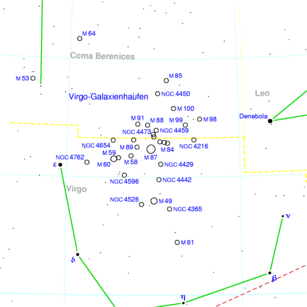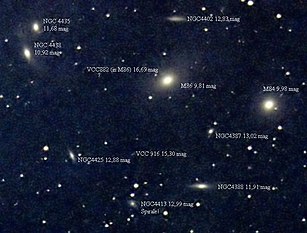Virgo Galaxy Clusters
The Virgo Galaxy Cluster is a galaxy cluster with at least 1300, but probably more than 2000 galaxies. It lies in the constellation Virgo (Virgo); its center is about 54 million light years away from the Milky Way .
The cluster also forms the center of the local supercluster , which is therefore also called the Virgo supercluster . The Local Group - the galaxy cluster to which the Milky Way and the Andromeda Nebula belong - is part of this supercluster like the Virgo Galaxy Cluster, but rather forms an extension of it.
Just north of the Virgo Cluster, but far behind, is the even larger Coma Cluster . The assignment of individual galaxies in the foreground and background was only possible a few decades ago.
discovery
The first member of the Virgo galaxy cluster was discovered by Charles Messier in February 1771 . The French astronomer had started to measure all the nebulae in the sky to prevent confusion with new comets . Today it is known that the misty cloud that Messier cataloged at the time was the giant elliptical galaxy Messier 49 . Messier later entered other bright member galaxies of the Virgo Cluster, some of which had been discovered by his friend Pierre Méchain between 1779 and 1781 , in his catalog. Among them was the giant galaxy Messier 87 , which is also known as Virgo A because of its strong radio emissions .
The Messier catalog contains a total of 16 galaxies that are now identified as members of the Virgo Cluster: M49 , M58 , M59 , M60 , M61 , M84 , M85 , M86 , M87 , M88 , M89 , M90 , M91 , M98 , M99 , and M100 . March 1781 can therefore be given as the time of the discovery of the galaxy cluster, because Messier himself entered the following sentences in his notes after the entry for M91 (translated from Kenneth Glyn Jones ):
“The constellation Virgo, and especially its northern part, is one of the constellations that contains the most nebulae. The catalog lists 13 that have been determined, namely the numbers 49, 58, 59, 60, 61, 84, 85, 86, 87, 88, 89, 90 and 91. All these nebulae do not seem to contain any stars and are at good Weather visible during the meridian passage. Mr Méchain drew my attention to most of these nebulae. "
Messier recognized even then that these nebulae form a group and that they are not star clusters . Of course , almost 150 years before the first observation of single stars in the Andromeda Nebula , he was unable to recognize the nature of the galaxies as star systems outside the Milky Way . It was not clarified until the 1920s to 1930s.
The bright sombrero galaxy M 104, which apparently belongs to this group due to its position in the sky, is not a member of the Virgo cluster because it is much closer.
Extension, distance and morphology
In the sky, the galaxy cluster extends over an area of about 8 degrees in the constellations Virgo and Haar der Berenike . The Hubble Space Telescope succeeded in dissolving Cepheids in members of the Virgo cluster for the first time in 1994 . Using the period-luminosity relationship of these stars, an exact distance measurement of 65 million light years was achieved, so that an approximate diameter of the group of around 9 million light years can be calculated. Like all galaxy clusters, the Virgo cluster is not to be understood as a closed system with a clearly defined boundary. Rather, the foothills of the cluster merge seamlessly into the large structure of the supercluster, and the extent given here therefore only refers to the area of the lighter galaxies.
The cluster consists of an average mix of spiral and elliptical galaxies . The spiral galaxies, however, are distributed over a cigar-shaped (prolate) ellipsoid that is about four times as long as it is wide and avoid the center of the cluster. This is a typical phenomenon in heavily populated galaxy clusters, as the spiral structure in the dense center of the cluster is destroyed by strong tidal forces .
The elliptical galaxies, on the other hand, distribute themselves more symmetrically and condense strongly towards the center of the cluster. The central area contains the three giant elliptical galaxies M 49 , M 60 and M 87 . The largest of these three galaxies, M 87, is about 10 times the size of the other two and has a mass of about 6 trillion solar masses within a radius of 50 kpc .
The distribution of all known galaxies in the cluster in the central area does not have a clearly defined center. The three giant galaxies rather form the centers of subgroups: Cluster A around M87 in the geometric center of the cluster is by far the largest of these groups with around 100 billion solar masses, or a good 300 times the mass of the Milky Way, cluster B around M 49 in the south forms a conspicuous sub-center and cluster C around M 60 is finally a comparatively small group to the east of cluster A. The large subgroup cluster A is again conspicuously divided into two parts: the main group around the giant M 87 and a smaller group around M 84 and M 86 , which together with some other bright galaxies form a linear structure called the Markaryan chain after their discoverer . (The beginning of the Markarian chain with M 84, M 86 and the pair NGC 4435 and NGC 4438 can be seen in the picture above.) In addition to the three large subgroups, the spiral galaxies further out with their companions form physical substructures. A typical example of this is the spiral galaxy M100 far north of the center.
The total mass of the galaxy cluster can be calculated using the so-called virial theorem of celestial mechanics and modern extensions of this theorem from the pecular velocities , i.e. H. from the deviations of the individual speeds of the members compared to the center of gravity. Since these peculiar speeds z. T. are very high (up to 1600 km / s in the case of the galaxy IC 3258 ), one obtains a value for the total mass that, at around 1.2 quadrillion solar masses, is significantly higher than the value obtained from counting and weighting the Galaxies by luminosity would expect. This effect was first observed by Sinclair Smith in 1936, making it one of the first indications of the existence of dark matter .
As already mentioned, galaxy clusters do not really form closed subsystems. There are indications that e.g. B. extends the cigar-shaped structure of the spiral galaxies of the Virgo Cluster even further and possibly even extends into the Coma galaxy cluster , the center of the neighboring supercluster. Filament-like extensions of the same structure also seem to extend into the area of the coma-sculptor cloud , which contains the local group.
Virgo Infall
The mass of the Virgo Cluster leads to a gravitational attraction of the remaining galaxies of the local supercluster. The fact that the Local Group is part of the Virgo Supercluster means that the Virgo Cluster's gravitational attraction is superimposed on the general cosmological Hubble Flux . The cosmological redshift of the galaxies of the Virgo cluster is therefore much lower at around 1000 km / s than one would expect at the given distance. With a modern value for the Hubble constant H 0 = 73 km / s / Mpc, about 1400 km / s would be expected - this value is e.g. B. reached almost exactly by the lower mass Fornax galaxy cluster, which is almost equally distant with about 60 million light years . The difference in speed between the Hubble flow and the actual speed of the local group corresponds to a relative movement towards the Virgo cluster and is called Virgo Infall .
Superimposed on the Virgo Infall is the movement of the Virgo Cluster as the center of the local supercluster itself. The Virgo Cluster moves towards the Hydra-Centaurus supercluster , and the entire complex of all neighboring superclusters is finally drawn towards the great attractor , its center that forms the Norma galaxy cluster . The speed vectors of all these movements add up to a total speed of the local group of about 600 km / s in one direction between the Virgo cluster and the large attractor.
Galaxies in the Virgo Cluster
There are about 30 galaxies in the Virgo Cluster that are brighter than the 10.5th magnitude:
|
|
Web links
- Flight to the Virgo Cluster (25 MB)
- Virgo pile. California Institute of Technology
- Heron Island Proceedings
- The Virgo Cluster . Atlas of the Universe
- The Virgo Cluster . Chandra X-Ray Observatory
- The Virgo Cluster of Galaxies . SEDS Messier pages
- CCD image of the Virgohaufen Center
- Spektrum.de : commented amateur recording
- Spektrum.de: Amateur recordings: [1] [2]
Individual evidence
- ^ Simona Mei et al .: The ACS Virgo Cluster Survey. XIII. SBF Distance Catalog and the Three-dimensional Structure of the Virgo Cluster . In: The Astrophysical Journal . 655, Jan 2007, pp. 144-162. bibcode : 2007ApJ ... 655..144M . doi : 10.1086 / 509598 .
- ^ French original of the Messier catalog at SEDS
- ↑ a b Virgo cluster at SEDS
- ↑ H. Bernhard, D. Bennett, H. Rice: New Handbook of the Heavens , chapter Units of the Universe . Signet Science Library, New York 1957.
- ↑ a b c d B. Bingli: The Virgo Cluster - Home of M87 . In: Working on the Virgo Cluster . Retrieved October 14, 2007.
- ↑ M. Fukugita, S. Okamura, N. Yasuda: Spatial distribution of spiral galaxies in the Virgo Cluster from the Tully-Fisher relation . In: ApJ . 309, No. 1, 1993, p. L39.
- ↑ David Merritt, Benoit Tremblay: The distribution of dark matter in the halo of M87 . In: The Astronomical Journal . 106, No. 6, December 1993, pp. 2229-2242. bibcode : 1993AJ .... 106.2229M . doi : 10.1086 / 116796 .
- ↑ P. Fouqué, JM Solanes, T. Sanchis, C. Balkowski: Structure, mass and distance of the Virgo cluster from a Tolman-Bondi model . In: Astronomy and Astrophysics . 375, No. 3, 2001, pp. 770-780. arxiv : astro-ph / 0106261 . bibcode : 2001A & A ... 375..770F . doi : 10.1051 / 0004-6361: 20010833 .
- ^ S. Smith: The mass of the Virgo cluster . In: Astrophysical Journal . 83, 1936, pp. 23-30. bibcode : 1936ApJ .... 83 ... 23S . doi : 10.1086 / 143697 .
- ↑ NASA / IPAC Extragalactic Database . In: Results for Virgo Cluster . Retrieved October 14, 2007.
- ↑ a b F. Combes et al .: Galaxies and Cosmology . Springer A&A Library, 1995, Chapter 11.6: Large Scale Motions. Virgo Infall

